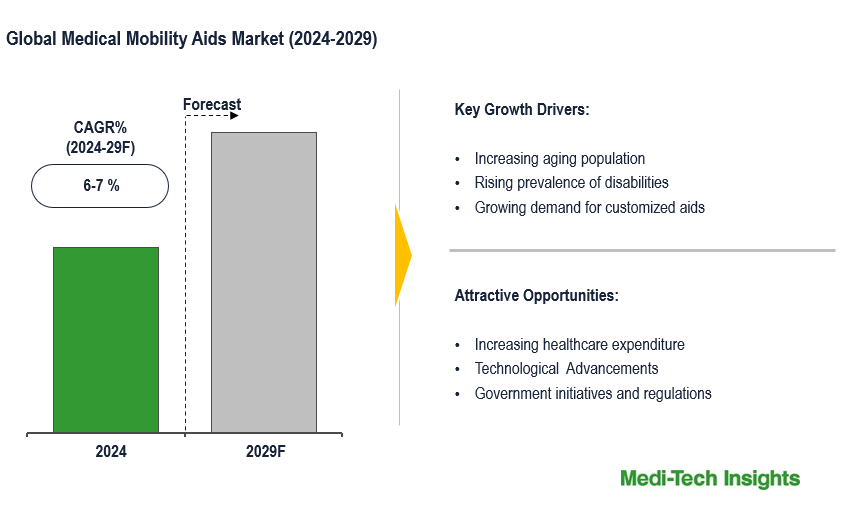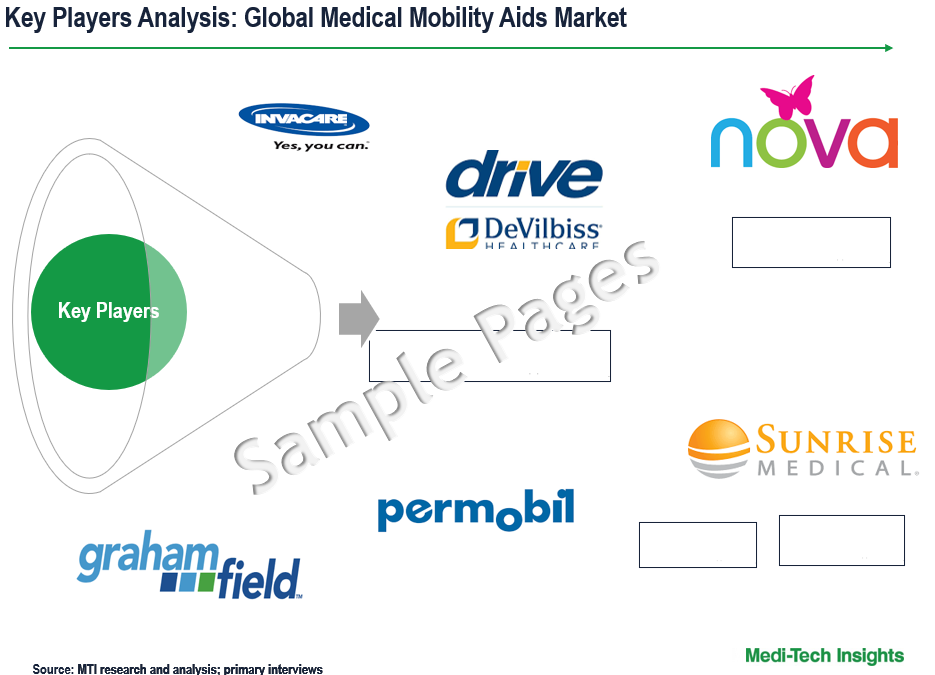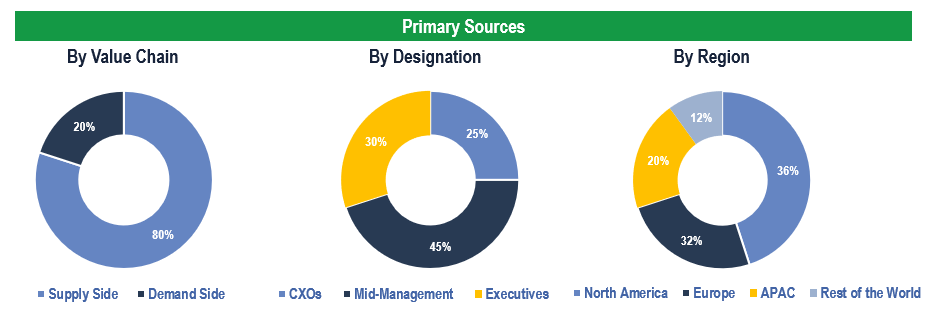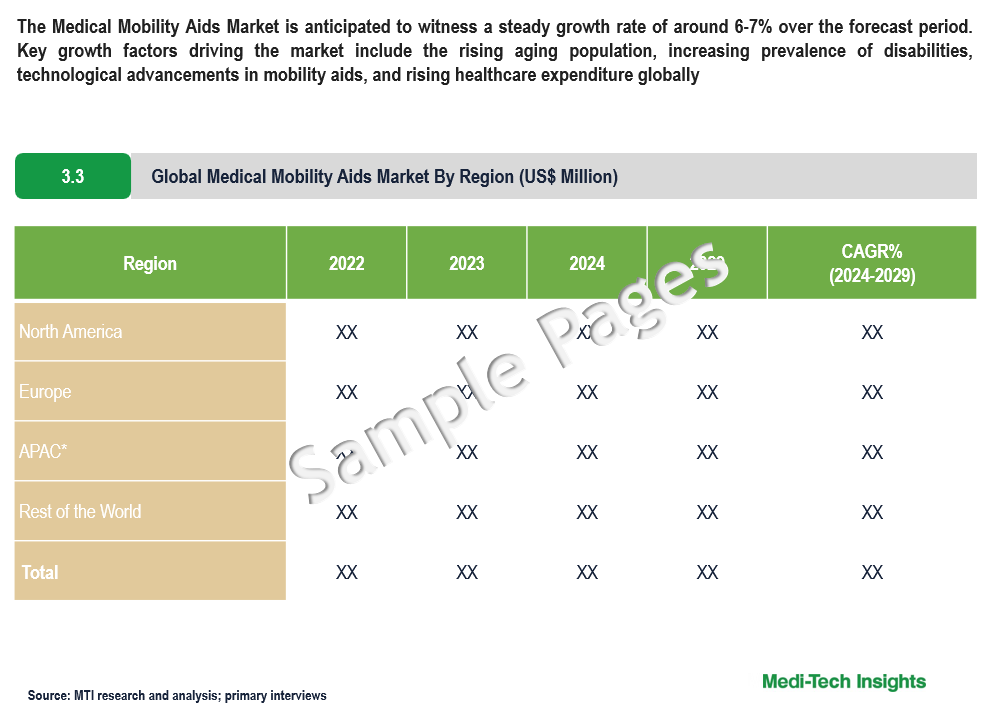
Medical Mobility Aids Market Size, Share, Growth, Opportunity, Innovation and Forecast to 2029
The Medical Mobility Aids Market is anticipated to witness a steady growth rate of around 6-7% over the forecast period. Key growth factors driving the market include the rising aging population, increasing prevalence of disabilities, technological advancements in mobility aids, and rising healthcare expenditure globally. These factors collectively contribute to the growing demand for mobility aids, particularly among elderly individuals and those with mobility impairments, propelling market growth. To learn more about the research report, download a sample report.
Medical mobility aids are devices designed to assist people with mobility impairments in moving around more easily and safely. These aids come in various forms and are tailored to meet the specific needs of individuals. Here are some common types of medical mobility aids:
- Wheelchairs: Wheelchairs are the most well-known mobility aids which provide mobility for individuals who have difficulty walking or standing for extended periods. Wheelchairs can be manual or electric, and they come in different sizes and designs to accommodate various needs
- Walkers: Walkers, also known as Zimmer frames, are supportive devices used by people who need assistance with walking. They typically consist of a metal frame with four legs and handgrips. Some walkers also have wheels on the front legs for easier maneuverability
- Crutches: Crutches are used by individuals who have temporary or permanent mobility limitations. They help support body weight and provide stability while walking. Crutches come in various types, including underarm crutches and forearm crutches
- Stairlifts: Stairlifts are motorized chairs attached to a track that is installed along a staircase. They allow individuals with mobility impairments to safely navigate stairs by sitting on a chair and being lifted or lowered along the track
When considering medical mobility aids, it's essential to consult with a healthcare professional or physical therapist to determine the most suitable options based on individual needs and abilities. Additionally, proper fitting and training on how to use the aids safely are crucial for maximizing their effectiveness and ensuring user safety.
Empowering Mobility: Addressing Growing Demands and Advancements in Medical Mobility Aids
With the global population aging, there is a notable increase in the elderly population facing mobility challenges associated with age-related conditions like arthritis, osteoporosis, and reduced mobility due to aging. Consequently, there is a rising demand for mobility aids such as wheelchairs, walkers, and scooters to support elderly individuals in maintaining their independence and mobility. The prevalence of disabilities stemming from accidents, injuries, or medical conditions such as strokes and spinal cord injuries further contributes to the growing need for mobility aids. These aids play a crucial role in enhancing independence and improving the quality of life for individuals with disabilities, driving demand in the market. For instance,
- In August 2022, Graham Field launched the PureTilt Tilt-in-Space Wheelchair, crafted by an Occupational Therapist, offers secure and independent transitions to enhance patient comfort, featuring a standard ergonomic, contoured back with adjustable height and user-adjusting tilt control for personalized posture readjustment throughout the day
Technological advancements have led to the development of innovative mobility aids equipped with features like improved functionality, enhanced comfort, and increased accessibility. These modern solutions appeal to consumers seeking cutting-edge mobility solutions that align with their lifestyles and preferences, thus driving market growth. Expansion of healthcare infrastructure, increased insurance coverage, changing lifestyles, and rising healthcare expenditure further contribute to market growth. Sustainability is another emerging trend, with manufacturers focusing on eco-friendly materials and recycling programs to minimize environmental impact. Governments worldwide are implementing initiatives and policies aimed at improving accessibility and promoting inclusivity for individuals with disabilities. These initiatives include regulatory measures, funding programs, and awareness campaigns that increase public awareness and support for mobility aid programs, consequently driving market growth. With a focus on improving the quality of life and independence of individuals with mobility impairments, the medical mobility aids market continues to evolve with innovative solutions and personalised care approaches.

To learn more about this report, download the PDF brochure
Emerging Trends in the Medical Mobility Aids Market
There's a growing integration of advanced technologies such as AI, IoT, and robotics into mobility aids like wheelchairs and walkers. These technologies aim to enhance user experience, improve functionality, and provide greater independence to users. Companies are focusing on offering customizable and personalized mobility solutions to meet the unique needs of individual users. This trend involves features like adjustable settings, ergonomic designs, and tailored accessories. Lightweight and portable designs are in demand, catering to active users seeking mobility aids for travel and various activities. Smart mobility solutions equipped with sensors and connectivity features are gaining traction, providing monitoring capabilities and navigation assistance. For instance,
- In November 2021, Drive DeVilbiss Healthcare collaborates with the BILT Video Assembly App to streamline product assembly, offering users a time-saving solution that includes features such as 3D walkthroughs, clear visuals, audio guidance, 360-degree image rotation, zooming, step replay, and access to essential information like warnings, cautions, required tools, parts list, and warranty details.
- In February 2021, Invacare Corporation unveiled the Invacare AVIVA STORM RX, marking a significant advancement in rear-wheel drive power wheelchairs and establishing a new standard in power mobility
AI and machine learning algorithms are being utilized to enhance the performance and functionality of mobility aids. These technologies can analyze user behaviour, predict movement patterns, and adapt the device's settings to optimize user comfort and safety. Manufacturers are prioritizing user comfort and safety by incorporating ergonomic designs, cushioning materials, and safety features such as anti-tip mechanisms, automatic brakes, and fall detection systems. With the increasing adoption of telemedicine, there's a trend towards integrating mobility aids with telehealth platforms. This allows users to easily communicate with healthcare providers, receive remote consultations, and access medical resources through their mobility devices. These emerging trends reflect a growing emphasis on improving the quality of life and independence for individuals with mobility impairments through innovative technological solutions and personalized care approaches in the medical mobility aids market.
Key Constraints/Challenges
The medical mobility aids market faces several challenges that impact its growth and accessibility. One significant challenge is the high cost associated with mobility aids, including wheelchairs, walkers, and scooters, which can pose financial barriers for individuals, particularly those with limited financial resources or inadequate insurance coverage. Another challenge is the complexity of navigating insurance coverage and reimbursement processes, which can be time-consuming and confusing for both users and healthcare providers. Furthermore, stigma and social barriers surrounding the use of mobility aids can impact adoption rates and deter individuals from seeking the assistance they need.
Regional Analysis of the Medical Mobility Aids Market
North America emerges as a prominent player in the medical mobility aids market, driven by a substantial aging population and a high prevalence of mobility challenges associated with age-related conditions. The region benefits from robust healthcare infrastructure and reimbursement policies, facilitating widespread access to mobility aids. Additionally, technological advancements and a strong focus on innovation contribute to market growth in North America.
Europe presents significant opportunities in the medical mobility aids market, supported by a growing elderly population and increasing awareness of the importance of mobility solutions. The Asia Pacific region demonstrates considerable potential for market expansion in medical mobility aids, fueled by rapid urbanization, rising healthcare expenditure, and improving healthcare infrastructure. Nations such as China, India, and Japan witness surging demand for mobility aids due to demographic shifts and an increasing focus on improving the quality of life for the aging population. Moreover, the adoption of advanced technologies and the emergence of innovative mobility solutions contribute to the region's market growth trajectory.
Competitive Landscape
Key players in the market include Invacare Corporation, Drive DeVilbiss Healthcare, GF Health Products, Inc., Sunrise Medical, Ottobock Healthcare GmbH, Permobil Group, Carex Health Brands, Inc., Kaye Products, Inc., Medline Industries, Inc., NOVA Medical Products, Performance Health, Stryker and Rollz International among others.

Get a sample report for competitive landscape analysis
Organic and Inorganic Growth Strategies Adopted by Players to Establish Their Foothold in the Market
Players operating in this market are adopting both organic and inorganic growth strategies such as collaborations, and acquisitions to garner market share. For instance,
- In September 2023, Permobil finalized its acquisition of PDG Mobility, enhancing Permobil's manual wheelchair portfolio and adding expertise in tilt-in-space products, known for their exceptional durability, functionality, design, and customer support
- In October 2023, Sunrise Medical revealed its strategic acquisition of Ride Designs, representing a notable expansion of its custom seating offerings, clinical expertise, and service capabilities, which seamlessly complement the wide array of manual and powered mobility products already provided by Sunrise Medical0
The Medical Mobility Aids Market is expected to gain momentum in the coming years due to the rising aging population, growing demand for customized mobility aids, technological advancements, strategic collaborations and aggressive organic and inorganic growth strategies followed by the players.
Key Strategic Questions Addressed
-
What is the market size & forecast for the Global Medical Mobility AidsMarket?
-
What are the historical, present, and forecasted market shares and growth rates of various segments and sub-segments of the Global Medical Mobility Aids Market?
-
How has COVID-19 impacted the Global Medical Mobility Aids Market?
-
What are the major growth drivers, restraints/challenges impacting the market?
-
What are the opportunities prevailing in the market?
-
What is the investment landscape?
-
Which region has the highest share in the global market? Which region is expected to witness the highest growth rate in the next 5 years?
-
Who are the major players operating in the market? What is the competitive positioning of key players?
-
Who are the new players entering the market?
-
What are the key strategies adopted by players?
- Research Methodology
- Secondary Research
- Primary Research
- Market Estimation
- Market Forecasting
- Executive Summary
- Market Overview
- Market Dynamics
- Drivers
- Restraints
- Opportunities
- Market Dynamics
- Global Medical Mobility Aids Market - Size & Forecast (2021-2028), By Product
- Wheelchairs
- Scooters
- Walking Aids
- Other Products
- Global Medical Mobility Aids Market - Size & Forecast (2021-2028), By End User
- Hospitals
- Nursing Homes
- Home-Care Settings
- Other End Users
- Global Medical Mobility Aids Market - Size & Forecast (2021-2028), By Region
- North America (U.S. & Canada)
- Europe (UK, Germany, France, Italy, Spain, Rest of Europe)
- Asia Pacific (China, India, Japan, Rest of Asia Pacific)
- Rest of the World (Latin America, Middle East & Africa)
- Competitive Landscape
- Key Players and their Competitive Positioning
- Competitive Positioning of Key Players (2022)
- Offerings Assessment, By Players
- Key Strategies Assessment, By Player (2021-2023)
- New Product Launches
- Partnerships, Agreements, & Collaborations
- Mergers & Acquisitions
- Other Developments
- Key Players and their Competitive Positioning
- Key Companies Scanned (Indicative List)
- Invacare Corporation
- Drive DeVilbiss Healthcare
- GF Health Products, Inc.
- Sunrise Medical
- Ottobock Healthcare GmbH
- Permobil Group
- Carex Health Brands, Inc.
- Kaye Products, Inc.
- Medline Industries, Inc.,
- NOVA Medical Products
- Performance Health
- Rollz International
- Other Players
The study has been compiled based on extensive primary and secondary research.
Secondary Research (Indicative List)

Primary Research
To validate research findings (market size & forecasts, market segmentation, market dynamics, competitive landscape, key industry trends, etc.), extensive primary interviews were conducted with both supply and demand-side stakeholders.
Supply Side Stakeholders:
- Senior Management Level: CEOs, Presidents, Vice-Presidents, Directors, Chief Technology Officers, Chief Commercial Officers
- Mid-Management Level: Product Managers, Sales Managers, Brand Managers, Business Development Managers, Consultants
Demand Side Stakeholders:
- Stakeholders in Hospitals, Nursing Homes, and Home-Care Settings among others
Breakdown of Primary Interviews

Market Size Estimation
Both ‘Top-Down and Bottom-Up Approaches’ were used to derive market size estimates and forecasts.
Data Triangulation
Research findings derived through secondary sources & internal analysis were validated with Primary Interviews, Internal Knowledge Repository, and Company Sales Data.


